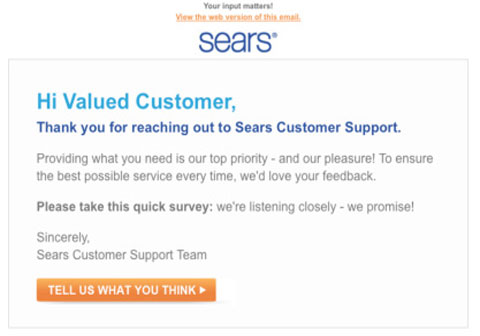
Closing the Digital Divide: Part 2: Customer Service

Call it serendipity, but I recently experienced a real-world example that supports the subject of my previous blog. That one dealt with the erosion of service on the part of traditional brick-and-mortar retailers forced to compete with warehouse discounters and online retailers. My basic premise was that decreasing margins and high overhead must ultimately result in reduced funding for customer service and merchandizing. Ironically, these are two of the primary, differentiating benefits these establishments have offer to consumers. When you couple this to the increasing improvements being made to online shopping and the influence of social media on product choice and purchasing behavior, even the most digitally resistant among us will eventually migrate toward a superior e-tail experience. To my mind, the days of the department store are definitely numbered. Their raisons d’etre–wide product selection, the convenience of one-stop shopping, and the economies of large-scale buying–are now all done better by online merchants.
Dancing with the dinosaur
Okay, now for my real-world experience, starring that venerable retail giant: Sears. Last winter my wife and I decided to replace the 1980s-era upright freezer that lived in our basement with a newer, energy-efficient model. Sears had one of their store-brand Kenmore freezers on sale. We went to the store, saw the unit, comparison shopped at other stores, came back and bought it (remember this process for later, folks).
After a few weeks we noticed frost developing on both the shelves and the food. After discovering that some of the packing materials hadn’t been properly removed by the Sears installers, we fixed what we thought was the problem. The frost continued to accumulate, however, and we called for service. The first technician told us that the thermostat was bad and put one on order. After it arrived a month later, a different technician came and determined that the thermostat was not the actual problem. We simply had purchased a non-frost-free appliance that would need to be emptied and defrosted every six to eight weeks!
They still manufacture non-frost-free freezers? I felt as though I had been sold a new television and then discovered it had a black & white picture and only received 13 channels! Our old unit was over 35 years old and that antique was frost-free. The salesman at Sears never mentioned this minor detail, information any salesman would normally use to steer a customer to a more expensive model. I sent a lengthy e-mail to Sears customer service with explicit reference to the poor performance of their sales, installation and service personnel, and my suspicions regarding the purposeful dumping of an unsellable product.
Comedy… the way Dante would have recognized it
Here’s where things get comical (unless you’re my wife, who is still livid over the thought of spending a day defrosting this beast every couple of months). After a few days I received a form-letter-style e-mail response thanking me for bringing this to their attention, informing me that it would be used to help them improve their service in the future, and expressing the hope that, “…you will continue to make Sears your choice for quality and value.” I had been clear and precise in stating my views regarding Sears’ quality and value in my rather lengthy diatribe. (I remember using the phrase, “Are you people just mailing it in?”). Apparently, my e-mail had never been read.
To add insult to injury… and then squeeze a little lemon juice on the running wound… I received the following e-mail about a week later, with the folksy “How did we do?” as the subject line.

I’m willing to bet that most, if not all, of this correspondence was never viewed by a sentient human being. When I compare this to the immediate and concerned attention I’ve received from Amazon and other online retailers, it’s hard to describe what Sears offers as “service” of any kind.
[imageframe lightbox=”no” style_type=”none” bordercolor=”” bordersize=”0px” stylecolor=”” align=”right” animation_type=”0″ animation_direction=”down” animation_speed=”0.1″ class=”” id=””][/imageframe]
I replied, of course, with extensive and detailed commentary on how customer service should actually be handled. This is what came back as a reply: “Oops! Looks like we goofed! We’ll try better next time.”
“Goofed”? I’d say so, and the issue goes deeper than they seem to realize. I’m willing to bet that most, if not all, of this correspondence was never viewed by a sentient human being. When I compare this to the immediate and concerned attention I’ve received from Amazon and other online retailers, it’s hard to describe what Sears offers as “service” of any kind.
Lessons to be learned
Now we get back to the premise of previous blog. My wife and I are older Baby Boomers, and the buying process I described earlier reflects behaviors we learned over decades; ones we have yet to completely shake off. But we’re getting there. What should we have done? For starters, instead of burning gas visiting other stores to comparison shop we should have gone online and checked out the Sears freezer, compared it to other products, and used social media to see what we could learn. Actually, this is exactly what I do when I’m planning to buy a new tool, piece of equipment, or a new car. Oddly enough, when it comes to household purchases I subconsciously default to the process my wife finds most comfortable. I think this experience has convinced both of us that those days are over, and I’m sure the same is happening with others of my generation.
Are there lessons to be learned by Sears or their brethren? I doubt it. As I said earlier, the problem goes directly to the competitive advantages that made department stores successful a century ago. For the most part, these advantages now belong to the online retailers. It is probably too late for them to transition to an all-online business model; others are already doing it better. Department store “brands” are suffering image erosion, and I have sincere doubts that they can successfully leverage social media the way that many product brands have been able to. What will the malls do with the space when these large anchor tenants disappear?
Epilogue
Never one to take being ignored for an answer, or a slap in the face as an acceptable form of punctuation, I addressed my displeasure via snail mail to the C-suite at Sears Holdings, the corporate parent. As they say, feces flow downhill, and we did receive a more intelligent, considered reply, and a promise to investigate the episode with a “Blue Ribbon” case number for future reference. We’ll probably wind up with a 20% discount on a future Kenmore appliance purchase (like that’s ever going to happen) or some other token gesture. Still, it is nice to feel that you have been listened to. Actually, that alone covers at least half of what good customer service should provide. It is also what the best of the e-commerce sites already offer as a matter of course.

